-- Published: Thursday, 1 December 2016 | Print | Disqus
By Gordon T Long
Investors need to focus on the two key long term structural changes now underway which are going to ignite destructive global dislocations through early 2020. To better understand why this is going to occur we need to place them in context by first examining the major economic cycles currently underway.
HARRY DENT'S MACROECONOMIC CYCLES & DEMOGRAPHICS
This initial cycle chart is from an in-depth discussion I had with Harry Dent earlier this year. Since leaving Harvard, Harry has spent most of his adult working life studying demographics and cycles.
An ominous tell tale is that the four cycles he most closely follows are all presently headed down or flat!
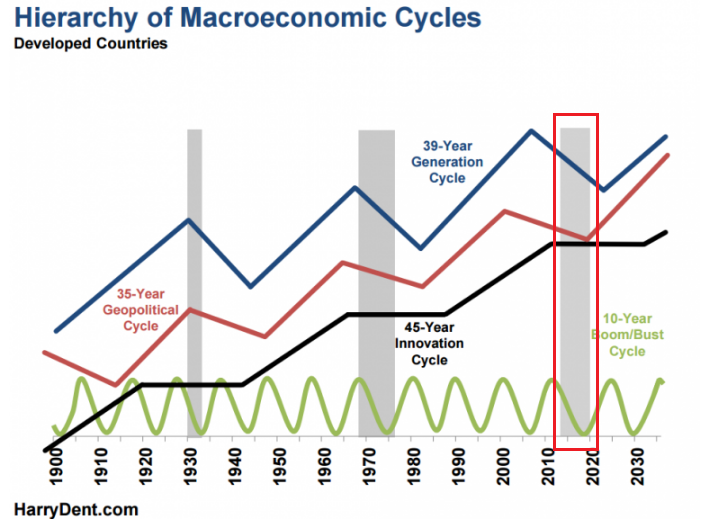
Dent attributes this to; the demographics of the baby boom generation, their spending habits as they enter retirement and the overall falling birth rates in the developed economies.
His work suggests the cycles don't reverse until the early '20's.
MARTIN ARMSTRONG'S "ECONOMIC CONFIDENCE MODEL"
Another well respected cycles analyst is Martin Armstrong who I additionally interviewed to discuss his highly regarded Economic Confidence Model. This cycle is based on a very long cycle of human history and civilization. It currently shows, according to Armstrong (see below), that economic conditions have been deteriorating since 2015.75 (Sept 2015) and will persist through to the beginning of 2020 (2020.05).

THE KONDRATIEFF LONG CYCLE
Another very well followed and researched cycle is the Kondratieff Long Cycle. This approximate 55 year or "generational"cycle is also suggesting that historically we should presently be headed lower into the "Kondratieff Winter" part of the four season cycle. The "Winter" cycle has been somewhat delayed as the debt & credit levels have not yet headed lower which they historically did during the last cycles when economies were operating under the gold standard and the major global currencies were not "fiat" .
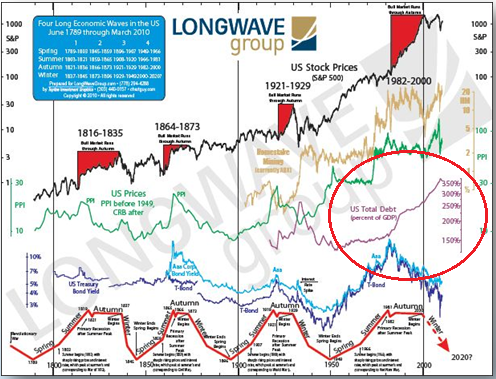
So what can we conclude other than it seems all the cycle theory and analysis indicates good times are not likely in front of us through early 2020?
Let's consider the analysis of my Macro Analyst co-host Charles Hugh Smith who recently published on the subject and together we explored further in our most recent Macro Analytics video.
PETER TURCHIN'S "AGES OF DISCORD"
Charles writes in "Now Is The Winter Of Our Discontent: An Era Of Rising Discord"
Do we control the slide into disorder and the emergence of a new order? The short answer is no: the forces at work are systemic and structural, and not controllable with the usual political/economic tools.
Historian Peter Turchin explores historical cycles of social disintegration and integration in his new book Ages of Discord.
Turchin proposes a model of rising discord that eventually leads to a new cycle of cooperation and compares the expected result with historical data. He finds 25-year cycles that combine into roughly 50-year cycles, comparable (though not identical with) Kondratieff's proposed economic cycles (see chart below). These 50-year cycles are part of longer 150 to 200-year cycles that move from cooperation through an age of discord and disintegration to a new era of cooperation.
This work draws upon his previous books, including War and Peace and War: The Rise and Fall of Empires, which I referenced in Following in Ancient Rome's Footsteps: Moral Decay, Rising Wealth Inequality (September 30, 2015) and The Lesson of Empires: Once Privilege Limits Social Mobility, Collapse Is Inevitable (April 18, 2016).
These long cycles parallel the cyclical analysis of David Hackett Fischer, whose masterwork The Great Wave: Price Revolutions and the Rhythm of History I've referenced many times over the years, most recently in We've Entered an Era of Rising Instability and Uncertainty (July 18, 2016).
Turchin's model identifies three primary forces in these cycles:
1. An over-supply of labor that suppresses real (inflation-adjusted) wages
2. An overproduction of essentially parasitic Elites
3. A deterioration in central state finances (over-indebtedness, decline in tax revenues, increase in state dependents, fiscal burdens of war, etc.)
These combine to influence the broader social mood, which is characterized in eras of discord by fragmented loyalty to self-serving special interests (disintegration) and in eras of cooperation by a desire and willingness to cooperate and compromise for the good of the entire society (integration).
Rising discord can be quantified in a Political Stress Index. Do we find evidence of Turchin's disintegrative forces in the present era?
1. Stagnating real wages due to oversupply of labor: check.
2. Overproduction of parasitic Elites: check.
3. Deterioration in central state finances: check.
Is it any wonder that political stress, however you want to measure it, is rising?
Cycles are the result of the interaction of complex, non-linear dynamics, and so they are not entirely predictable in terms of pinpointing the exact moment of crisis or the outcome of a systemic crisis.
If we study Turchin's model and Fischer's work on Price Revolutions and the Rhythm of History, it becomes increasingly difficult to believe central planning policy tweaks can ensure a permanent extension of cooperation and prosperity.
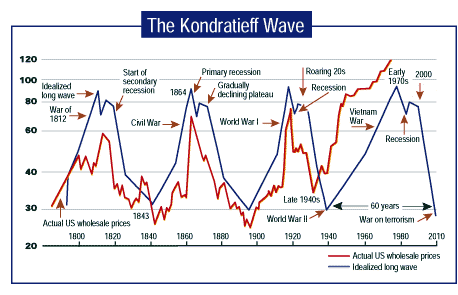
Turchin's thesis seems to add some explanation as well as somewhat integrating the popular cycles we initially referenced.
SOCIONOMICS

The recent emergence of "Socionomics", spear headed by Robert Prechter of Elliott Wave renown also sheds light on the root of these overlapping cycles.
Socionomics is a field of study conducted under the hypothesis that waves of social mood motivate the character of social actions.
What is social mood? Social mood is a shared mental state among humans that arises from social interaction. Social mood predisposes individuals in the group toward emotions, beliefs and actions. It fluctuates constantly in a fractal pattern. It is unconscious, unremembered and endogenously regulated.
How long has socionomics been around? Robert Prechter began developing the idea in the 1970s, and it first reached a mass audience in a 1985 cover article in Barron’s. Since then, researchers have applied the hypothesis to explain events including election results, trends in popular culture, the timing of epidemics and pandemics, the emergence of prohibition movements, and financial manias and crashes.
The Socionomic Institute illustrates that:
- Political Correctness lives and dies with Social Mood,

- Negative Social Mood has polarized America and majorities have deeply negative views of other parties,
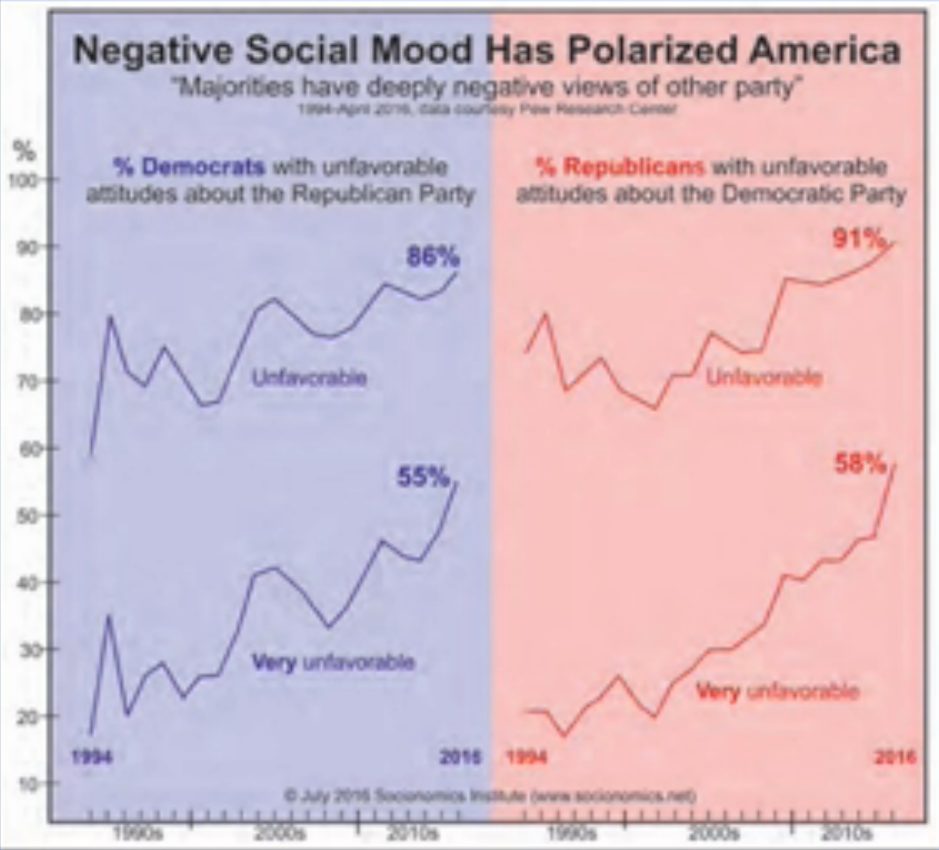
- Political Polarization has exploded since 2000

This leads us to conclude that Political Polarization, lack of cooperation, rebellion against political correctness are all presently manifesting themselves into a rejection of the status quo, "the system" and those trusted with its maintenance.

It appears to only beginning and Europe appears to be its next "hot spot".
BREXIT - TRUMP -- IT'S ONLY BEGINNING!
The Italian Constitutional Referendum on December 4th, 2016 is potentially as impactful as BREXIT and the shock of Trump being elected President of the USA. Both can be seen as potential rejections of the status quo and potentially why the Italian Referendum vote will fail, result in toppling the Italian government and opening the door for the anti-EU, Anti-establishment 5 Star party led by former comedian and political satirist Beppi Brillo.The epitome of the anti-establishment candidate.
There is a steady sequential set of highly charged political events throughout Europe coming in 2017 which portends of mounting political instability and social unrest.
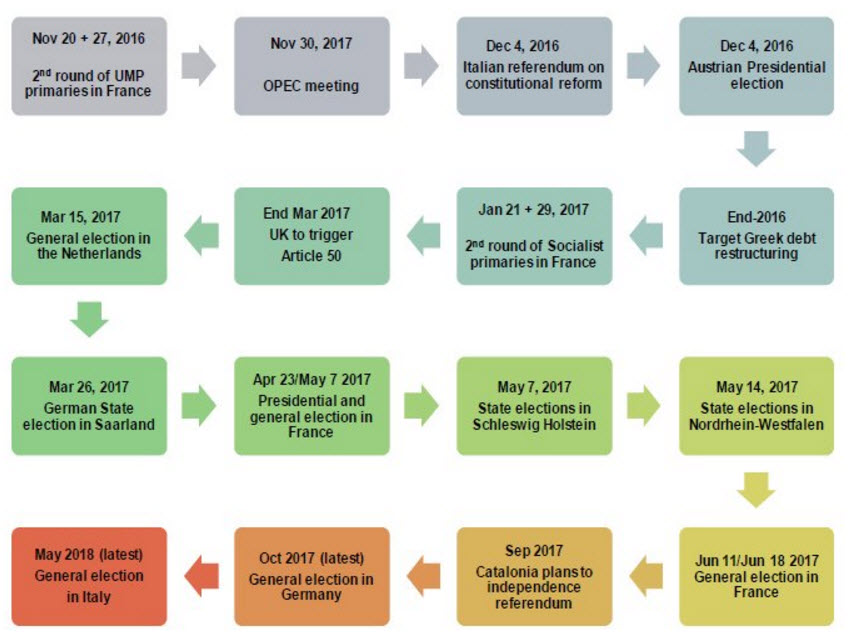
A FUSE, AN EXPLOSIVE AND THE IGNITING CATALYST
We sense that all of the above leads to and further assists in driving two key long term structural changes now underway:
First, there is now a clear shift in attitude within the electorate of the Developed Economies towards Anti-Globalization. Existing Free Trade Agreements, Tariffs and Protectionism are all now on the table.
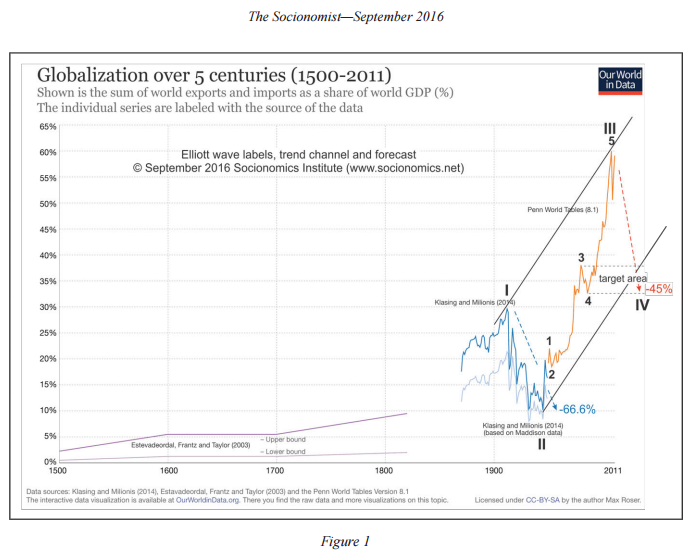
Secondly, the Debt Super Cycle is coming to an end. It is the fuse that will ignite this combustible mixture. The explosive mixture is about the Fiat paper reserves underpinning the global economic system which are presently built on failing wealth creation which is required to maintain the collateral values supporting the pyramided debt leverage levels through financial "gimmicks" such as rehypothecation. The approximate $600T derivative SWAPs market is the explosive within this mixture.

The catalyst to ignite the fuse will likely be correcting financial markets that are historically highly over-valued, disconnected from fundamentals and can only be described as in the third and final central bank bubble of the new millennium.
No doubt it is going to be both an exciting and troubling period between now and early 2020. You, dear reader, must determine which it is going to be for you personally?
https://matasii.com/
| Digg This Article
-- Published: Thursday, 1 December 2016 | E-Mail | Print | Source: GoldSeek.com

